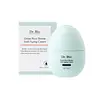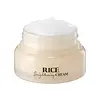What's inside
What's inside
 Key Ingredients
Key Ingredients

 Benefits
Benefits

 Concerns
Concerns

 Ingredients Side-by-side
Ingredients Side-by-side

Water
Skin ConditioningGlycerin
HumectantButylene Glycol
HumectantButylene Glycol Dicaprylate/Dicaprate
EmollientPentaerythrityl Tetraethylhexanoate
EmollientPhenyl Trimethicone
Skin ConditioningNiacinamide
Smoothing1,2-Hexanediol
Skin ConditioningCetyl Ethylhexanoate
EmollientDimethicone
EmollientHydrogenated Vegetable Oil
EmollientStearic Acid
CleansingC14-22 Alcohols
Emulsion StabilisingBehenyl Alcohol
EmollientMannitol
HumectantSqualane
EmollientArachidyl Alcohol
EmollientPolyacrylate-13
C12-20 Alkyl Glucoside
EmulsifyingCarbomer
Emulsion StabilisingMicrocrystalline Cellulose
AbsorbentTromethamine
BufferingArachidyl Glucoside
EmulsifyingPolyisobutene
Sucrose
HumectantEthylhexylglycerin
Skin ConditioningAllantoin
Skin ConditioningZea Mays Starch
AbsorbentAdenosine
Skin ConditioningHydroxypropyl Methylcellulose
Emulsion StabilisingPolysorbate 20
EmulsifyingSorbitan Isostearate
EmulsifyingHydrolyzed Lupine Protein
Skin ConditioningArachidic Acid
CleansingPalmitic Acid
EmollientGlucose
HumectantOleic Acid
EmollientPanthenol
Skin ConditioningBifida Ferment Lysate
Skin ConditioningLactobacillus Ferment Lysate
Skin ConditioningOryza Sativa Extract
AbsorbentStreptococcus Thermophilus Ferment
HumectantHydrogenated Lecithin
EmulsifyingCeramide NP
Skin ConditioningDipropylene Glycol
HumectantCholesterol
EmollientMacadamia Ternifolia Seed Oil
EmollientSodium Hyaluronate
HumectantButyrospermum Parkii Butter
Skin ConditioningBrassica Campestris Sterols
EmollientTocopherol
AntioxidantSodium Ascorbyl Phosphate
AntioxidantAscorbic Acid
AntioxidantBiotin
AntiseborrhoeicCyanocobalamin
Skin ConditioningFolic Acid
Skin ConditioningPyridoxine
Skin ConditioningRiboflavin
Cosmetic ColorantThiamine Hcl
MaskingWater, Glycerin, Butylene Glycol, Butylene Glycol Dicaprylate/Dicaprate, Pentaerythrityl Tetraethylhexanoate, Phenyl Trimethicone, Niacinamide, 1,2-Hexanediol, Cetyl Ethylhexanoate, Dimethicone, Hydrogenated Vegetable Oil, Stearic Acid, C14-22 Alcohols, Behenyl Alcohol, Mannitol, Squalane, Arachidyl Alcohol, Polyacrylate-13, C12-20 Alkyl Glucoside, Carbomer, Microcrystalline Cellulose, Tromethamine, Arachidyl Glucoside, Polyisobutene, Sucrose, Ethylhexylglycerin, Allantoin, Zea Mays Starch, Adenosine, Hydroxypropyl Methylcellulose, Polysorbate 20, Sorbitan Isostearate, Hydrolyzed Lupine Protein, Arachidic Acid, Palmitic Acid, Glucose, Oleic Acid, Panthenol, Bifida Ferment Lysate, Lactobacillus Ferment Lysate, Oryza Sativa Extract, Streptococcus Thermophilus Ferment, Hydrogenated Lecithin, Ceramide NP, Dipropylene Glycol, Cholesterol, Macadamia Ternifolia Seed Oil, Sodium Hyaluronate, Butyrospermum Parkii Butter, Brassica Campestris Sterols, Tocopherol, Sodium Ascorbyl Phosphate, Ascorbic Acid, Biotin, Cyanocobalamin, Folic Acid, Pyridoxine, Riboflavin, Thiamine Hcl
Water
Skin ConditioningGlycerin
HumectantButylene Glycol
HumectantIsopentyldiol
HumectantCaprylic/Capric Triglyceride
MaskingPropanediol
SolventPolyglyceryl-3 Distearate
EmulsifyingTriethylhexanoin
Masking1,2-Hexanediol
Skin ConditioningNiacinamide
SmoothingDiphenylsiloxy Phenyl Trimethicone
Skin ConditioningVinyldimethicone
Glyceryl Stearate
EmollientBetaine
HumectantSodium Polyacrylate
AbsorbentCarbomer
Emulsion StabilisingGlyceryl Stearate Citrate
EmollientTromethamine
BufferingXanthan Gum
EmulsifyingEthylhexylglycerin
Skin ConditioningAdenosine
Skin ConditioningOryza Sativa Extract
AbsorbentOryza Sativa Bran Water
MaskingOryza Sativa Seed Water
AntimicrobialAspergillus Ferment
Skin ConditioningDipotassium Glycyrrhizate
HumectantGlycine
BufferingSerine
MaskingGlutamic Acid
HumectantAspartic Acid
MaskingLeucine
Skin ConditioningAlanine
MaskingLysine
Skin ConditioningArginine
MaskingTyrosine
MaskingPhenylalanine
MaskingValine
MaskingProline
Skin ConditioningThreonine
Isoleucine
Skin ConditioningHistidine
HumectantMethionine
Skin ConditioningCysteine
AntioxidantHydrolyzed Rice Protein
Skin ConditioningGluconolactone
Skin ConditioningCaprylhydroxamic Acid
Trehalose
HumectantSh-Oligopeptide-1
Skin ConditioningProtease
ExfoliatingDisodium EDTA
Parfum
MaskingWater, Glycerin, Butylene Glycol, Isopentyldiol, Caprylic/Capric Triglyceride, Propanediol, Polyglyceryl-3 Distearate, Triethylhexanoin, 1,2-Hexanediol, Niacinamide, Diphenylsiloxy Phenyl Trimethicone, Vinyldimethicone, Glyceryl Stearate, Betaine, Sodium Polyacrylate, Carbomer, Glyceryl Stearate Citrate, Tromethamine, Xanthan Gum, Ethylhexylglycerin, Adenosine, Oryza Sativa Extract, Oryza Sativa Bran Water, Oryza Sativa Seed Water, Aspergillus Ferment, Dipotassium Glycyrrhizate, Glycine, Serine, Glutamic Acid, Aspartic Acid, Leucine, Alanine, Lysine, Arginine, Tyrosine, Phenylalanine, Valine, Proline, Threonine, Isoleucine, Histidine, Methionine, Cysteine, Hydrolyzed Rice Protein, Gluconolactone, Caprylhydroxamic Acid, Trehalose, Sh-Oligopeptide-1, Protease, Disodium EDTA, Parfum
Ingredients Explained
These ingredients are found in both products.
Ingredients higher up in an ingredient list are typically present in a larger amount.
1,2-Hexanediol is a synthetic liquid and another multi-functional powerhouse.
It is a:
- Humectant, drawing moisture into the skin
- Emollient, helping to soften skin
- Solvent, dispersing and stabilizing formulas
- Preservative booster, enhancing the antimicrobial activity of other preservatives
Adenosine is in every living organism. It is one of four components in nucleic acids that helps store our DNA.
Adenosine has many benefits when used. These benefits include hydrating the skin, smoothing skin, and reducing wrinkles. Once applied, adenosine increases collagen production. It also helps with improving firmness and tissue repair.
Studies have found adenosine may also help with wound healing.
In skincare products, Adenosine is usually derived from yeast.
Learn more about AdenosineButylene Glycol (or BG) is used within cosmetic products for a few different reasons:
Overall, Butylene Glycol is a safe and well-rounded ingredient that works well with other ingredients.
Though this ingredient works well with most skin types, some people with sensitive skin may experience a reaction such as allergic rashes, closed comedones, or itchiness.
Learn more about Butylene GlycolCarbomer is a polymer of acrylic acid. Its main role is to create a gel consistency.
A high amount of carbomer can cause pilling or balling up of products. Don't worry, most products contain 1% or less of carbomer.
Ethylhexylglycerin (we can't pronounce this either) is commonly used as a preservative and skin softener. It is derived from glyceryl.
You might see Ethylhexylglycerin often paired with other preservatives such as phenoxyethanol. Ethylhexylglycerin has been found to increase the effectiveness of these other preservatives.
Glycerin is already naturally found in your skin. It helps moisturize and protect your skin.
A study from 2016 found glycerin to be more effective as a humectant than AHAs and hyaluronic acid.
As a humectant, it helps the skin stay hydrated by pulling moisture to your skin. The low molecular weight of glycerin allows it to pull moisture into the deeper layers of your skin.
Hydrated skin improves your skin barrier; Your skin barrier helps protect against irritants and bacteria.
Glycerin has also been found to have antimicrobial and antiviral properties. Due to these properties, glycerin is often used in wound and burn treatments.
In cosmetics, glycerin is usually derived from plants such as soybean or palm. However, it can also be sourced from animals, such as tallow or animal fat.
This ingredient is organic, colorless, odorless, and non-toxic.
Glycerin is the name for this ingredient in American English. British English uses Glycerol/Glycerine.
Learn more about GlycerinNiacinamide is a multitasking form of vitamin B3 that strengthens the skin barrier, reduces pores and dark spots, regulates oil, and improves signs of aging.
And the best part? It's gentle and well-tolerated by most skin types, including sensitive and reactive skin.
You might have heard of "niacin flush", or the reddening of skin that causes itchiness. Niacinamide has not been found to cause this.
In very rare cases, some individuals may not be able to tolerate niacinamide at all or experience an allergic reaction to it.
If you are experiencing flaking, irritation, and dryness with this ingredient, be sure to double check all your products as this ingredient can be found in all categories of skincare.
When incorporating niacinamide into your routine, look out for concentration amounts. Typically, 5% niacinamide provides benefits such as fading dark spots. However, if you have sensitive skin, it is better to begin with a smaller concentration.
When you apply niacinamide to your skin, your body converts it into nicotinamide adenine dinucleotide (NAD). NAD is an essential coenzyme that is already found in your cells as "fuel" and powers countless biological processes.
In your skin, NAD helps repair cell damage, produce new healthy cells, support collagen production, strengthen the skin barrier, and fight environmental stressors (like UV and pollution).
Our natural NAD levels start to decline with age, leading to slower skin repair, visible aging, and a weaker skin barrier. By providing your skin niacinamide, you're recharging your skin's NAD levels. This leads to stronger, healthier, and younger looking skin.
Another name for vitamin B3 is nicotinamide. This vitamin is water-soluble and our bodies don't store it. We obtain Vitamin B3 from either food or skincare. Meat, fish, wheat, yeast, and leafy greens contain vitamin B3.
The type of niacinamide used in skincare is synthetically created.
Learn more about NiacinamideOryza Sativa Extract comes from the rice grain, Oryza sativa. Rice extract has wound healing, antioxidant, anti-inflammatory, and hydrating properties.
Rice grains contain numerous antioxidants which may help with anti-aging, such as vitamin E. Antioxidants help stabilize free-radical molecules. Unstable free-radical molecules may damage your skin cells and accelerate signs of aging.
A study from 2002 found rice to help increase the rate of wound healing. The same study found an improvement of skin barrier function in the patients after taking rice baths.
Numerous in-vitro studies have found rice water to help decrease sun damage by increasing collagen production and inhibiting the process of tyrosinase.
Long story short- tyrosinase is an enzyme that controls melanin production. Our bodies start producing melanin (AKA tanning) when exposed to UV radiation to protect against damage. Rice water is found to partially block this process.
Though more research is needed on rice's ability to help with UV protection, recent studies seem promising.
Wondering why rice is hydrating? The protein in rice have emollient properties. Emollients create a barrier on the skin to trap moisture in, keeping your skin moisturized.
Some rice extract may have mildly-exfoliating properties. These are mainly limited to Oryza Sativa (Rice) Bran and Oryza Sativa (Rice) Germ Powder.
This rice was first cultivated in China over 10,000 years ago. Many cultures throughout Asia have used rice water on skin and hair for centuries.
Learn more about Oryza Sativa ExtractTromethamine helps balance the pH and improve the texture of a product. It is synthetically created.
As an emulsifier, Tromethamine prevents oil and water ingredients from separating. This helps stabilize the product and elongate a product's shelf life. Tromethamine also makes a product thicker.
Tromethamine helps balance the pH level of a product. Normal pH level of skin is slightly acidic (~4.75-5.5). The acidity of our skin is maintained by our glands and skin biome. Being slightly acidic allows our skin to create an "acid mantle". This acid mantle is a thin barrier that protects our skin from bacteria and contaminants.
Oral Tromethanmine is an anti-inflammatory drug but plays the role of masking, adding fragrance, and/or balancing pH in skincare.
1,3-Propanediol, 2-amino-2-(hydroxymethyl)-
Learn more about TromethamineWater. It's the most common cosmetic ingredient of all. You'll usually see it at the top of ingredient lists, meaning that it makes up the largest part of the product.
So why is it so popular? Water most often acts as a solvent - this means that it helps dissolve other ingredients into the formulation.
You'll also recognize water as that liquid we all need to stay alive. If you see this, drink a glass of water. Stay hydrated!
Learn more about Water